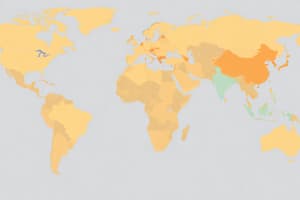Podcast
Questions and Answers
What is the main factor contributing to the wealth disparity between rich and poor countries?
What is the main factor contributing to the wealth disparity between rich and poor countries?
- Differences in social welfare systems
- Unequal distribution of global spending on education and healthcare
- Varying levels of urbanization and rural development
- All of the above (correct)
How do social welfare systems in rich countries differ from those in poor countries?
How do social welfare systems in rich countries differ from those in poor countries?
- There is no difference in social welfare systems between rich and poor countries
- Rich countries have weak or nonexistent social welfare systems
- Poor countries have stronger social welfare systems than rich countries
- Rich countries' social welfare systems help protect citizens against market fluctuations (correct)
What is the general trend in global spending on education?
What is the general trend in global spending on education?
- A significant portion of global spending on education goes towards developed countries (correct)
- Global spending on education is decreasing overall
- Global spending on education is evenly distributed between developed and developing countries
- Most global spending on education goes towards emerging and developing nations
How do rural areas in rich countries compare to rural areas in poor countries?
How do rural areas in rich countries compare to rural areas in poor countries?
Which of the following statements about urbanization is true?
Which of the following statements about urbanization is true?
What exception is mentioned in the text regarding developing countries' progress in education and healthcare?
What exception is mentioned in the text regarding developing countries' progress in education and healthcare?
What per capita Gross Domestic Product (GDP) value distinguishes rich countries from poor countries?
What per capita Gross Domestic Product (GDP) value distinguishes rich countries from poor countries?
What is a common characteristic of rich countries in terms of economic growth rate compared to poor countries?
What is a common characteristic of rich countries in terms of economic growth rate compared to poor countries?
Which type of goods do rich nations mainly export in international trade?
Which type of goods do rich nations mainly export in international trade?
Which group of countries has demonstrated impressive growth rates in recent decades despite not being considered rich?
Which group of countries has demonstrated impressive growth rates in recent decades despite not being considered rich?
What do less affluent nations tend to export in exchange for advanced technology or industrial know-how?
What do less affluent nations tend to export in exchange for advanced technology or industrial know-how?
Which factor contributes significantly to the economies of both rich and poor countries?
Which factor contributes significantly to the economies of both rich and poor countries?
Flashcards are hidden until you start studying
Study Notes
Rich vs Poor Countries Comparison
In comparing rich and poor countries, it's essential to understand some key differences in their socioeconomic indicators, which can help us better understand the challenges faced by these nations. Here we will discuss various aspects of development between wealthy and less affluent nations.
But first, let's define what constitutes rich and poor countries? A country is considered rich when its per capita Gross Domestic Product (GDP) is over $12,536 USD. On the other hand, a nation with a per capita GDP below that amount is considered poor.
Comparison on Economy and Trade
Economic Growth Rate
Rich countries typically have higher economic growth rates than poor ones due to their stable economies and investments in infrastructure. However, this doesn't mean poor nations can't grow rapidly; many have experienced high growth rates under the right circumstances. For instance, countries like Singapore, Hong Kong, South Korea, Taiwan, and China have all demonstrated impressive growth rates in recent decades.
International Trade
International trade plays a significant role in the economies of both rich and poor countries. Rich nations are often importers of raw materials from developing countries and exporters of finished goods. In contrast, less affluent nations tend to export raw materials or cheap labor-intensive products in exchange for advanced technology or industrial know-how. This dynamic contributes significantly to the wealth disparity between these two groups of nations.
Social Welfare Systems
Social welfare systems in rich countries help protect citizens against market fluctuations, while those in poor countries may be weak or nonexistent.
Education and Healthcare
Education and healthcare are crucial indicators of a nation's development level. Generally speaking, rich countries boast better education and health care facilities compared to their poor counterparts. A significant portion of global spending on education goes towards developed countries, with the rest allocated to emerging and developing nations. Similarly, the majority of global spending on healthcare is directed towards wealthy countries, leaving limited resources available for other nations.
However, there are exceptions where some developing nations have made substantial progress in improving their educational and healthcare standards, such as Cuba and Costa Rica. Despite this, overall, less affluent countries still face considerable challenges in providing quality education and healthcare services for their populations.
Urbanization vs Rural Areas
While urbanization has been a trend across most regions globally, it does not necessarily translate into prosperity. Rapid urbanization without proper planning can lead to overpopulation, pollution, substandard housing, and lack of basic amenities. On the contrary, rural areas in rich countries often enjoy higher living standards, access to modern amenities, and better infrastructure compared to their counterparts in poorer nations.
In summary, comparing rich and poor countries reveals stark differences in various aspects of socioeconomic development. While progress is being made in several developing nations, there remains an extensive gap between rich and poor countries. Addressing this discrepancy requires concerted efforts by governments, international organizations, and civil society alike, aiming at fostering sustainable economic growth, promoting equitable distribution of resources, and ensuring universal access to essential public services.
Studying That Suits You
Use AI to generate personalized quizzes and flashcards to suit your learning preferences.




